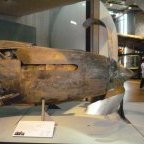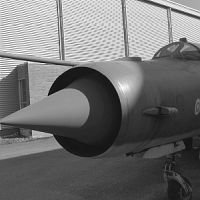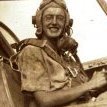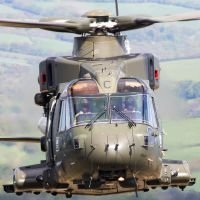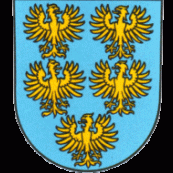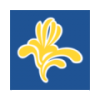Search the Community
Showing results for tags 'Hobby Boss'.
-
When all is up in the air, concentrate on something familiar and re-assuring - like a Sea Hawk model! This is the 1/72 Hobby Boss kit, with Modeldecal transfers to correct some anomalies in the kit markings. At least I hope they "correct" ! What a marvelous little kit this is, even allowing for the age of the Airfix one that I am more familiar with. Its only real issue is the intake vane arrangement, which is too prominent. I did cut this one's vanes back, but clearly not far enough. I have 3 more in the stash to build and looking forward to them. And the collection grows: Stay safe everyone..... FredT
- 6 replies
-
- 25
-

-
- 1/72
- Hobby Boss
-
(and 1 more)
Tagged with:
-
Hello guys! After nearly three months without scale models to build, I was able to snatch this one from a Facebook seller, Hobby Boss's Mirage IIICJ in 1:48. I won't be using the kit decals, I'll use the ones printed by Condor Decals (of Argentina). The final scheme will be of a Mirage IIICJ based at El Plumerillo Ait Base, Mendoza, 1986. Here are the obligatory box, sprues and decals shots:
- 1 reply
-
- Argentina
- Mirage IIIC
-
(and 1 more)
Tagged with:
-
F9F-2 Panther, VF-123 Kit: Hobby Boss F9F-2 Panther (#87248) Scale: 1/72 Paints: Vallejo Model Color, Model Air & Metal Color Weathering: Flory Models Wash Good quality kit from Hobby Boss, really enjoyable build.
- 12 replies
-
- 31
-

-

-
- Hobby Boss
- F9F
-
(and 1 more)
Tagged with:
-
MiG-15UTI 'Mukelo', Finnish Air Force Kit: MiG-15UTI Midget (#80262) Scale: 1/72 Aftermarket: Kuivalainen Photo Etch, decals (origin unknown) Paints: Vallejo Model Color, Model Air & Metal Color Weathering: Flory Models Wash Nice little kit from Hobby Boss, very good value for money. Built in a week. Built for Nordic GB. Build thread:
- 1 reply
-
- 13
-

-
- Mig-15UTI
- Hobby Boss
-
(and 1 more)
Tagged with:
-

Hobby Boss Messerschmitt Me.262A-1b By my Son
Mike posted a topic in Ready for Inspection - Aircraft
Over the last few weeks my son Christopher (that's him in my avatar) has been getting more interested in modelling after playing a bit of War Thunder and watching some documentaries with me. He decided he wanted to build another model now he's getting older (still 9 y/o) - He's built two as a wee nipper, a Cromwell tank and an I-16 which he used mostly paint brushes on, although he did dabble with an airbrush at times. This time he was determined to do a good job, and despite a little bit of impatience here and there, he's achieve that in spades, and made his old dad proud This is the Hobby Boss kit that he chose and I bought for him (he's not having any of mine!), and he's built mostly unaided over a number of sessions during lockdown. It's all airbrushed, and 99% of the work is his. He couldn't be bothered with the decals when they came around, so I did those for him, and I think I gloss coated the underside, but everything else you see is his work. Oh, and I had to glue in the landing gear with CA because they were a bit squiffy. He didn't do much with the cockpit other than paint it grey after it was in the fuselage, and gave the same treatment to the gear bays. I was his airbrush servant, filling and cleaning it for him, as I didn't want to put him off so early and the colour suggestions were mine. We had a problem with my RLM76 being empty when I opened it, so we used the next nearest colour from the same brand (Gunze). So, with great pride I introduce my wickle boy's first proper model He's particularly proud of the underside, as it looks like it's seen some action on the front, and you may also notice that we'd forgotten to add the pitot probe and a couple of aerials when I took the pics, so we'll add those as long as we can find them Speaking of finding, we've lost the retraction jack on the nose gear, but it's a sturdy connection so it shouldn't matter, and I've straightened it up since the photos. The next techniques he needs to master (other than patience) is cockpits, weathering wheel bays, seams, and patience. Did I mentioned patience yet? Patience. How awesome is that for a 9 year old though? EDIT: We've got a very happy Christopher here, and he's very touched by all your comments. We thought we'd put another pic up with the last few bits added for good measure, and he insisted on painting in the wingtip lights, so I suggested a layer of silver with translucent green and red over the top. He even got to use my W&N Series 7, so is a true modeller now -
Yak-28PP Brewer-E (81768) 1:48 Hobby Boss via Creative Models Ltd. First flying in the late 50s, the Yak-28 was an early Soviet swept wing design that began life as a bomber but was adapted to fulfil other roles such as interceptor, reconnaissance and electronic warfare. The PP was the electronic warfare variant and carried no weapons, instead the bomb bay was filled to the brim with electronic countermeasures, making it the first Soviet EW aircraft. The radome was replaced by a greenhouse nose cone, and an operator’s position was added in the nose with a canopy that opened up in front of the main cockpit. To dump the heat created by the electronics, there were lumps and bumps on the underside of the aircraft to help dissipate the excess and prevent overheating. There were numerous attempts to improve on the basic airframe, but none proceeded past prototype, although the PM did achieve a speed record while the Yak-28-64 had wing root mounted engines giving it a more modern look, but again was cancelled before it reached production. It was eventually replaced by the Su-24 in many of its roles, including the Electronic Warfare role of the Brewer-E. The Kit This is a fairly major retool of the original Yak-28P Firebar that we reviewed here late last year. It arrives in a similar box with painting of the type on the lid, and inside are ten sprues in grey styrene, two of clear parts and a small decal sheet. The instruction booklet and separate colour painting guide complete the package, with only wings, engines and landing gear sprues carried over from the P. Complete new fuselage, tail and cockpit sprues have been tooled for this variant, along with a beautifully detailed greenhouse for the nose cone, which has been slide-moulded to obtain maximum detail on the framing. Two of the smaller sprues contain rocket pods that are mounted under the outer wing in the instruction, but as this variant usually flew without armament, it is unlikely they were actually carried, so check your references before making holes in the wings. Construction begins with the pilot’s solo cockpit, which revolves around the long tub with instrument panels (with decals), bulkheads, control column and seat added before the sidewalls are installed. The seat has good detail and consists of seven parts but no lap-belts visible on the cushions, although can easily add those from tape or foil. Like the Harrier, the Firebar had bicycle undercarriage with a nose wheel and one main gear leg toward the aft of the fuselage with each bay boxed in with good detail, and struts with retraction jacks added along the way. While they can be left off until later the supporting jack on the nose wheel could be difficult to fit retrospectively, so check this in advance of applying too much glue. The front cockpit is formed by adding a detail insert and window into each side of the front fuselage, then while closing up the fuselage, a bulkhead and an additional ejection seat is inserted along with an ancillary instrument panel visible from the lip of the compartment. All the assemblies have good supports and tabs within the fuselage to assist with positioning. Once you have dealt with the seams, there are numerous cooling lumps and antennae to be added along the bottom of the fuselage, some of which covers the seam and reduces the amount of making good needed there. A louvered panel is inserted in front of the rear gear well, and the instructions would have you adding the bay doors at this stage, which is fine if you won’t be masking and painting, but otherwise they’re best left off until later. Flipping the fuselage over the airbrake in either open or closed configuration is added, the nose glazing, top cover for the EW officer with clear window, coaming and rear deck are installed along with a few more ill-advised antennae, with the pilot’s canopy left off until later. The engine pods bear a passing resemblance to extended Me.262 pods and each one has two main cowlings with a rear blanking plate, stator blades and nose cone enhancing that feeling. The intake is close enough to the cone that more detail isn't really visible to anyone with normal levels of inquisitiveness especially when the intake lip is added to the assembly, so there aren't any blades depicted on the plate. At the rear a four-part exhaust is provided with blades visible at the end of the trunking, and a nice tapered exhaust tip. Tons of small slide-moulded intakes are added to each side along with clear vision ports toward the front, and of course this assembly is repeated in mirror image for the other nacelle. Additional fuel tanks are joined at this stage, with each one being handed for its own wing due to its close-fitting nature. The wings are simple assemblies of two parts with holes needing drilling depending on whether you plan to fit the supplied pods, and they incorporate the tops of the engine pods that the main sections are added to during their construction. The short wingtip mounted stabiliser wheels that fit into their bays with two doors, retraction jacks, wheels and yoke are fitted, as are the fuel tanks and those rocket pods if you really must. There are also wing-fences and more intakes on the engine cowling, plus a small flap between the fuselage and engine pods and a pointed fairing near each wingtip that attaches to a small cut-out in the wing surface. The new tail is separate from the fuselage and consists of two parts for the fin with another for the rudder, then two single part elevators half-way up the fin are fitted on two pins each, and a couple of blade antennae swept in the direction of flight. Adding the wings to their slots in the fuselage, gluing in the two canopy parts and fitting the pointy probe on the nose completes the build. Markings Hobby Boss aren’t renowned for their verbose informative decal instructions, and this kit is no different, although it does have two quite different options depicted on the little decal sheet that accompanies the kit. From the box you can build either a three-colour camouflaged aircraft with grey/blue lower, or a silver machine, about which we know very little from studying the large and colourful painting guide, which shows four views that will be particularly useful for the camouflaged option. The decals are printed to HB’s usual standard and are workmanlike in their sharpness and colour density. The majority are plain red or red and white, so registration isn’t an issue, but the instrument decals are worth pointing out because they are very well done with crisp details and colour where necessary. Conclusion If you’re in the market for a Brewer-E, this will be a nice addition to the stash, and with Hobby Boss’s penetration into the market, it’s also fairly easy to get hold of. Detail is very good throughout, and it should build up into a nice model. Do the camo one – you know you want to! Highly recommended. Review sample courtesy of
-
My entry for this blitzbuild will be Hobby Boss's 1/72 Land-Wasser-Schlepper. Still undecided on whether it will be a the Superhero Option or the Other Option.
-
Blitz...Lightning...geddit? 1/48 kit from Hobby Boss, will be completed in the lower natural metal scheme. Going for the 24-hour option, will be kicking off at 0900 BST on Saturday. Good luck everybody! 👍
-
Right. So we got one extra week - and @trickyrich tricked me to build one more. Oh well, why not! So let's go with something that is doable in a week: Hobby Boss easy assembly kit. And so that it's not too easy - some Kuivalainen (Eduard) etch. Decals - not sure where I got those... This MiG-15UTI actually ties in nicely my Finnish planes in this GB. Gnat was the first proper fighter in the Finnish Air Force since the war that was atleast somewhat relevant at the time of it's purchase. It was quickly outclassed though - as the aviation industry was moving so fast. MiG-21F-13 followed - and while it did not replace Gnat as such (Draken did), it made it more or less obsolete in FAF. With the purchase of the MiG-21's, four MiG-15UTI's were also bought. It was used as interim trainer between the Fouga Magister and MiG-21F as no dedicated two seater MiG-21 trainer was available. But MiG-15UTI proved to be of little use in Finnish Air Force, there was no real need for such plane type. But, my point being - the thing that ties my Finnish GB builds together - Gnat, MiG-21F-13 and MiG-15UTI all served in the Finnish Air Force at the same time. Whats in the box. It's labeled as an 'Easy Assembly' kit - but it's still a proper kit nevertheless. Pretty nice detail, just maybe little less parts than normally. Like the wings are one part and so on. PE will detail nicely the rather spartan cockpit. Cockpit without PE... ... and with PE. All the extra bits, ready for primer. ... aand the fuselage & wings assembled! I better stop now so that I don't have to post this to the RFI area straight away
- 27 replies
-
- 6
-

-

-
So the longest project finally finished. Quality of model itself as usually Hobby Boss or Trumpeter. I'm sure I've made some mistake and missed few things, but by the end it is only piece of plastic, isn't it?
- 12 replies
-
- 20
-

-

-
- T-28
- Hobby Boss
-
(and 1 more)
Tagged with:
-
Morning all, Build number eight for the year is a subject I'm incredibly fond of, the epic Rafale Marine. Base kit is the rather average Hobby Boss kit, which isn't particularly accurate in places and isn't the best fit in areas too, one of the reasons I chose not to enter into the Navy GB in case I made a mess of it... I've built it as it comes from the box, warts and all- I made a right mess of the canopy so please don't look too closely..... Finished using Hataka Orange Line- there's always a lot of contention over French colours, but I found on this build that Light Ghost Grey with a few drops of Dark Gull Grey added creates a close enough match for the base colour, which I darkened further to add the shading and staining. The main markings came from an old Model Alliance sheet, which whilst toned down compared to the overly bright kit decals, still required a post shade to dull them down to an acceptable level. Seems no one can get these right! Weathering came courtesy of MIG Productions neutral wash and oilbrusher. I always enjoy building a model of an aircraft I have seen, so I elected to finish the model as No. 11 of Flotille 12F, which I caught at the 2012 Yeovilton Air Day. 1/72 Hobby Boss Dassault Rafale M by Shaun Schofield, on Flickr 1/72 Hobby Boss Dassault Rafale M by Shaun Schofield, on Flickr 1/72 Hobby Boss Dassault Rafale M by Shaun Schofield, on Flickr 1/72 Hobby Boss Dassault Rafale M by Shaun Schofield, on Flickr 1/72 Hobby Boss Dassault Rafale M by Shaun Schofield, on Flickr And the jet itself Dassault Rafale M 11 Aeronavale RNAS Yeovilton 24/06/12 by Shaun Schofield, on Flickr Thanks for looking, comments welcomed, especially any tips on how to prevent the paint on canopy framing lifting with the masking tape, something that has plagued me in recent builds.... Cheers, Shaun
-
-
Hi all, here is the latest build off the production line Hobby Boss' 1/48 (actually nearer to 1/51) SAAB J-29F Tunnan. By no means the most accurate kit but what it lacks in accuracy it more than makes up for in terms of ease of build. there is barely a smidge of filler anywhere on the kit and it has been a very enjoyable build. I painted it with Vallejo metallic paints and Gunze for the camouflage and used decals from Moose Republic which are light years ahead of the truly awful ones which come with the kit. I hope you enjoy the pictures. For those of you interested here is a link to the WIP; https://www.britmodeller.com/forums/index.php?/topic/235067561-good-grief-some-idiots-bought-the-hobby-boss-tunnan-and-hes-going-to-build-it/ And please check out the other fantastic builds in the ongoing excellent Nordic GB that this was built as part of. As usual all comments and criticisms are gratefully received. Thanks for looking. Craig.
- 20 replies
-
- 31
-

-
#8/2020 And here´s the second part of ma dad´s D-13 dual build. Not as fancy looking as "yellow 10" but these were the only two known D-13 schemes. Hobby Boss kit, Eduard seatbelts, markings from the Eduard D-11/D-13 dual combo, camo done with MRP paints, EZ line for the antenna wire. As usual some details added. The HB kit isn´t bad. It´s basically their D-9 kit with a gunless upper cowl and the bigger side airintake. Molding quality and fit was very good. Luckily it has an open wheel well, but sadly the rear engine parts are placed way too much forward. To fill the void my dad added some scratch parts, tubing and wiring. Build thread here https://www.britmodeller.com/forums/index.php?/topic/235066232-end-of-war148-focke-wulf-fw190d-13-possibly-ejg2/ Only two Fw190D-13s are currently photographically documented. This one was found at Pilsen – Bory airfield with the engine dismantled at the end of the war. The Black Stab marking on the fuselage shows that this particular aircraft was flown by the Gruppenkommandeure. The exact operator of this Dora is not known, and V./EKG 2 formed from I./EKG(J) is one of the possibilities. If this theory is correct, then this Dora was flown by Hptm. Walter Grasemann. Nevertheless, thanks to confusion during final days of the war, this aircraft could also have been flown by other units, such as JG 2 or JG 6.The series of at least fifteen Fw 190D-13s was manufactured by Weser Flugzeugbau in March and April, 1945. DSC_0021 by grimreaper110, auf Flickr DSC_0022 by grimreaper110, auf Flickr DSC_0023 by grimreaper110, auf Flickr DSC_0024 by grimreaper110, auf Flickr DSC_0025 by grimreaper110, auf Flickr DSC_0026 by grimreaper110, auf Flickr DSC_0027 by grimreaper110, auf Flickr DSC_0028 by grimreaper110, auf Flickr DSC_0029 by grimreaper110, auf Flickr DSC_0030 by grimreaper110, auf Flickr DSC_0031 by grimreaper110, auf Flickr DSC_0032 by grimreaper110, auf Flickr DSC_0033 by grimreaper110, auf Flickr DSC_0034 by grimreaper110, auf Flickr DSC_0035 by grimreaper110, auf Flickr DSC_0036 by grimreaper110, auf Flickr DSC_0037 by grimreaper110, auf Flickr DSC_0038 by grimreaper110, auf Flickr DSC_0039 by grimreaper110, auf Flickr DSC_0040 by grimreaper110, auf Flickr and here together with Yellow 10 built with the Eduard kit DSC_0041 by grimreaper110, auf Flickr DSC_0042 by grimreaper110, auf Flickr DSC_0043 by grimreaper110, auf Flickr
-
Hello guys, here's my latest model, Gerhard Barkhorn's Bf 109G-6 in 1:48. I used Eduard instructions to guide me with the camouflage scheme, I think it came out pretty good.
- 2 replies
-
- 5
-

-
- Hobby Boss
- Luftwaffe
-
(and 1 more)
Tagged with:
-
Hello guys, I finished another model. This time it's the Hobby Boss 1:48 Ta 152C-11.
- 3 replies
-
- 8
-

-
- Ta 152
- Hobby Boss
-
(and 1 more)
Tagged with:
-
German 12.8cm Flak 40 (84545) 1:35 Hobby Boss via Creative Models Ltd The Flak 40 suffered from a protracted development period that began in 1936, and ended with limited service as a static emplacement that was famously mounted on the flak turrets in Berlin to defend the last remnants of the Reich. This stemmed from the overly heavy mounting that made it difficult to transport and resulted in its use in the emplacements that were mounted on concrete bases for stability. The gun was also used as a Zwilling dual mount in the anti-aircraft role, but the reduced weight towable version lost the contest with the Krupp Pak.44 that was more mobile than the Rheinmetall Flak 40, with Hitler himself sealing its fate. The Kit This is a new tool from Hobby Boss of this dead(ish)-end project, and it’s pretty large and impressive. It arrives in a standard Hobby Boss box with their usual slightly corrugated surface and tight-fitting lid. Inside is a card divider separating the wheels and axles from the rest of the parts on their sprues. In total there are thirteen sprues in grey styrene, nine flexible tyres and a small sheet of Photo-Etch (PE) brass, plus the instruction booklet and a separate painting guide that shows off just how long this thing is when attached to its bogies. Construction begins with the pedestal, which has four pivoting legs and ground anchors that you can leave free to pivot if you don’t use any glue. The base of the gun is next, and is a substantial assembly to support the weight of the massive gun and its heavy-weight breech, which is assembled from a large number of parts and includes rollers to assist the crew with shell insertion. The finished barrel and breech are mated, with a small PE ring slipped over the muzzle and slid down to the step, then the assembly is slipped into the carriage and it is surrounded by the huge elevation and recoil mechanisms, which telescope inside each other like the hydraulic rams they replicate to facilitate elevation. A Shell cradle fits on the left of the carriage, then the base of the gun is joined up and the rams are attached to the base accompanied by the aiming, crew seating and adjustment wheels over the next few pages. Another chunk of the loading mechanism is assembled and added to the side, then the crew work platforms are fabricated from tubular plastic frames and tread-plated floor panels. The gun is then completed by twisting the assembly into the pedestal that was made up earlier. There are two large bogies to be made up, and each of these begin with the shaped chassis, across which the huge leaf spring units and wishbones fit on two axles, with tanks attached on each side of the rail under the pivot point. Both bogies have four wheels made up from three-piece hubs and flexible black tyres, which fit neatly onto the axle, and are joined by the central “fifth wheel” pivot-point, then covered with a swooping cowl, cable bobbins and the towing arm. They attach to the folded gun via two large lugs toward the rear of each bogie and a third pin that locates further under the gun. The front bogie differs in that it also has a spare tyre on the cowling, which gives you a good clue as to which is the front of the finished item. The gun is over 35cm long in travel mode, and best part of 10cm wide, with that width increasing if you decide to build it off the bogies and fold out the legs. Markings Not on this kit baby, and it’s gonna be grey as it was built earlier in the war as a prototype. If you’re going to model it as a fictitious in-service piece from an alternate timeline, the world is your oyster of course. Conclusion It’s massive, and will look great in a collection of German WWII artillery pieces, especially if you have the victorious Pak.44 for comparison. The instructions don’t really give you much information about setting the gun up for firing, and as such I feel that you are intended to build it in transport mode, which makes me wonder how accurate the ends of the uncovered fixing lugs on the bogies would be in this instance. You’ll need to do some checking of references if you also feel this to be the case. Highly recommended. Review sample courtesy of
-
HobbyBoss is to release a 1/48th Kamov Ka-27 "Helix" - ref. 81739 Source: http://tieba.baidu.com/p/2804569608 V.P.
- 38 replies
-
- Helix
- Hobby Boss
-
(and 1 more)
Tagged with:
-
Hello I started building the Kraz log-in truck using the PanzerShop conversion kit. Scale 1:35. Enjoy the pictures.
-
The Hobby Boss catalog is usually unveiled in early December. 2017-2018 - https://www.britmodeller.com/forums/index.php?/topic/235012994-hobby-boss-catalog-2017-2018-complete-programme-now-online/ 2018-2019 - https://www.britmodeller.com/forums/index.php?/topic/235030323-hobby-boss-catalog-2018-2019-programme/ 2019-2020 - https://www.britmodeller.com/forums/index.php?/topic/235047346-hobby-boss-catalog-2019-2020-programme/ I'm really curious to discover the 2020-2021 catalog a/c novelties. We already know they are 1/32nd A-26/B-26 invader kits in the pipe line, but what else? link To be followed V.P.
- 9 replies
-
- catalog
- Hobby Boss
-
(and 1 more)
Tagged with:
-
The Hobby Boss catalog is usually unveiled in early December. 2017-2018 - link 2018-2019 - link I'm really curious to discover the 2019-2020 catalog a/c novelties. To be followed V.P.
- 8 replies
-
- Hobby Boss
- catalog
-
(and 1 more)
Tagged with:
-
Hobby Boss is to re-box (with new decals ?) its 1/48th Republic P-47D Thunderbolt kit as ref. 85811 Release expected in China in late September 2019. Source: http://www.hobbyboss.com/index.php?g=home&m=article&a=show&id=143&l=en In box review of the 2012 original boxing - ref. 85804: https://www.cybermodeler.com/hobby/kits/hb/kit_hb_85804.shtml V.P.
- 3 replies
-
- 2
-

-
- Hobby Boss
- Thunderbolt
-
(and 1 more)
Tagged with:

